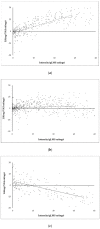Quantifying Sweet Taste Liker Phenotypes: Time for Some Consistency in the Classification Criteria
- PMID: 30634558
- PMCID: PMC6357166
- DOI: 10.3390/nu11010129
Quantifying Sweet Taste Liker Phenotypes: Time for Some Consistency in the Classification Criteria
Abstract
Taste hedonics is a well-documented driver of food consumption. The role of sweetness in directing ingestive behavior is largely rooted in biology. One can then intuit that individual differences in sweet-liking may constitute an indicator of variations in the susceptibility to diet-related health outcomes. Despite half a century of research on sweet-liking, the best method to identify the distinct responses to sweet taste is still debated. To help resolve this issue, liking and intensity ratings for eight sucrose solutions ranging from 0 to 1 M were collected from 148 young adults (29% men). Hierarchical cluster analysis (HCA) revealed three response patterns: a sweet-liker (SL) phenotype characterized by a rise in liking as concentration increased, an inverted U-shaped phenotype with maximum liking at 0.25 M, and a sweet-disliker (SD) phenotype characterized by a decline in liking as a function of concentration. Based on sensitivity and specificity analyses, present data suggest the clearest discrimination between phenotypes is seen with 1.0 M sucrose, where a liking rating between -15 and +15 on a -50/+50 scale reliably distinguished individuals with an inverted U-shaped response from the SLs and the SDs. If the efficacy of this approach is confirmed in other populations, the discrimination criteria identified here can serve as the basis for a standard method for classifying sweet taste liker phenotypes in adults.
Keywords: classification method; hedonics; individual differences; sweet taste; sweetness; taste test.
Conflict of interest statement
V.I. declares no conflict of interest. J.E.H. has received speaker fees, travel reimbursements, and/or consulting fees from federal agencies, nonprofit organizations, trade/commodity groups, and corporate clients in the food industry. M.R.Y has received direct research funding from numerous sources including national and international companies, as well as speaker fees, travel reimbursements, and consultancy fees from various companies, none of which impact on the work reported here. The funders had no role in the design of the study; in the collection, analyses, or interpretation of data; in the writing of the manuscript; or in the decision to publish the results.
Figures






Similar articles
-
Phenol-Rich Food Acceptability: The Influence of Variations in Sweetness Optima and Sensory-Liking Patterns.Nutrients. 2021 Mar 6;13(3):866. doi: 10.3390/nu13030866. Nutrients. 2021. PMID: 33800789 Free PMC article. Clinical Trial.
-
Effects of Sweet-Liking on Body Composition Depend on Age and Lifestyle: A Challenge to the Simple Sweet-Liking-Obesity Hypothesis.Nutrients. 2020 Sep 4;12(9):2702. doi: 10.3390/nu12092702. Nutrients. 2020. PMID: 32899675 Free PMC article.
-
Multiple Dimensions of Sweet Taste Perception Altered after Sleep Curtailment.Nutrients. 2019 Aug 27;11(9):2015. doi: 10.3390/nu11092015. Nutrients. 2019. PMID: 31461917 Free PMC article.
-
Understanding sweet-liking phenotypes and their implications for obesity: Narrative review and future directions.Physiol Behav. 2021 Jun 1;235:113398. doi: 10.1016/j.physbeh.2021.113398. Epub 2021 Mar 23. Physiol Behav. 2021. PMID: 33771526 Review.
-
Alterations in sweet taste function in adults with diabetes mellitus: a systematic review and potential implications.Crit Rev Food Sci Nutr. 2023;63(16):2613-2625. doi: 10.1080/10408398.2021.2015282. Epub 2021 Dec 14. Crit Rev Food Sci Nutr. 2023. PMID: 34904473
Cited by
-
Phenol-Rich Food Acceptability: The Influence of Variations in Sweetness Optima and Sensory-Liking Patterns.Nutrients. 2021 Mar 6;13(3):866. doi: 10.3390/nu13030866. Nutrients. 2021. PMID: 33800789 Free PMC article. Clinical Trial.
-
Impact of Taste on Food Choices in Adolescence-Systematic Review and Meta-Analysis.Nutrients. 2020 Jul 3;12(7):1985. doi: 10.3390/nu12071985. Nutrients. 2020. PMID: 32635385 Free PMC article.
-
Study protocol of the sweet tooth study, randomized controlled trial with partial food provision on the effect of low, regular and high dietary sweetness exposure on sweetness preferences in Dutch adults.BMC Public Health. 2023 Jan 11;23(1):77. doi: 10.1186/s12889-022-14946-4. BMC Public Health. 2023. PMID: 36627602 Free PMC article.
-
Characterizing Individual Differences in Sweet Taste Hedonics: Test Methods, Locations, and Stimuli.Nutrients. 2022 Jan 15;14(2):370. doi: 10.3390/nu14020370. Nutrients. 2022. PMID: 35057551 Free PMC article.
-
Relationships between Intensity and Liking for Chemosensory Stimuli in Food Models: A Large-Scale Consumer Segmentation.Foods. 2021 Dec 21;11(1):5. doi: 10.3390/foods11010005. Foods. 2021. PMID: 35010132 Free PMC article.
References
-
- De Graaf C., Boesveldt S. The chemical senses and nutrition: The role of taste and smell in the regulation of food intake. In: Tepper B., Yeomans M., editors. Flavor, Satiety and Food Intake. John Wiley & Sons, Inc.; Chichester, UK: Hoboken, NJ, USA: 2017.
-
- Finlayson G., Dalton M. Hedonics of Food Consumption: Are Food ‘Liking’ and ‘Wanting’ Viable Targets for Appetite Control in the Obese? Curr. Obes. Rep. 2012;1:42–49. doi: 10.1007/s13679-011-0007-2. - DOI
-
- Hayes J. Measuring sensory perception in relation to consumer behavior. In: Delarue J., Lawlor B., Rogeaux M., editors. Rapid Sensory Profiling Techniques. Woodhead Publishing; Cambridge, UK: 2015. pp. 53–69.
MeSH terms
Substances
Grants and funding
LinkOut - more resources
Full Text Sources

